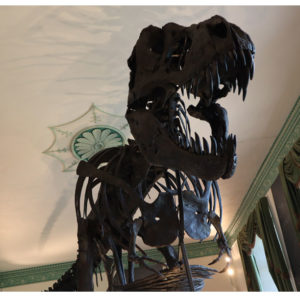Tyrannosaurs have Changed a lot in the Last Decade
Scientific Understanding of T. rex Revised by a Decade of New Research and Discoveries
Tyrannosaurus rex may be the most iconic of all the dinosaurs, but the Tyrannosauroidea family are a bit of an enigma, how these large, Late Cretaceous predators evolved has remained very much of a mystery to palaeontologists. However, over the last ten years or so, our understanding of these most famous of all the dinosaurs has grown tremendously as new discoveries have been made and new research techniques to existing fossils applied.
Tyrannosaurus rex
Since the Barnum Brown discoveries in the early 20th century that led to Osborn’s formal description of Tyrannosaurus rex, this dinosaur has certainly captured the imagination. So nearly called Dynamosaurus, the “King of the Tyrant Lizards” has become one of the most famous and iconic entities on the planet. If T. rex was a brand it would be alongside the household names, or perhaps as well known as the most famous footballers of today. However, as more tyrannosaur fossil material is discovered and more fossils studied scientists have learnt more about these theropods in the last ten years or so than they did in the preceding century.
To read an article published by Everything Dinosaur in 2007 acknowledging 100 years of T. rex research: Celebrating 100 years of Tyrannosaurus rex.
One of the Original Papo Replicas of Tyrannosaurus rex

The last of its kind, the Papo green standing T. rex dinosaur model. An earlier interpretation of T. rex.
The picture above shows a T. rex model that was first produced around fifteen years ago, our views about this dinosaur have changed considerably in the last ten years.
The dinosaur model is from the original Papo model series, to view the range of Papo dinosaur models in stock at Everything Dinosaur: Papo Dinosaur and Prehistoric Animal Models.
A New Scientific Paper
Raising the awareness of a new paper that summarises this research, team members at Everything Dinosaur were sent a press release from the communications team at the American Museum of Natural History (New York). Tyrannosaurus rex continues to intrigue, but thanks to a lot of dedicated and devoted scientists we are beginning to understand the phylogeny and the taxonomic relationships between tyrannosaurs and other members of the Dinosauria. In a scientific journal “Science” more details about the research into the tyrannosaur family and their family tree has been published, for us at Everything Dinosaur, T. rex and company remain pretty cool dinosaurs.
We’ve all heard this story: the Late Cretaceous of Asia and North America—about 66 million years ago—was dominated by several large-headed, bipedal predatory dinosaurs like Tyrannosaurus rex and Tarbosaurus that had tiny arms. But a decade of new fossil discoveries that have more than doubled the number of known tyrannosaur species has changed this tale.
Older and smaller tyrannosaurs have made the evolutionary tree of this group richer and more complex. Furthermore, a series of innovative research projects on topics like bone growth and biomechanics have added an enormous amount of information about tyrannosaurs, so much so that the group could now be considered an exemplar for studying many themes in palaeontology research.
Mark Norell, curator in the Division of Palaeontology at the American Museum of Natural History stated:
“T. rex is the most iconic of all dinosaurs. Its star power has allowed a research focus into questions not normally undertaken with fossils, questions like bone growth, biomechanics and neurology.
Up Close to the “Business End” of a T. rex
Picture credit: Everything Dinosaur.
Stephen Brusatte, a graduate student affiliated with the American Museum of Natural History and the first author of this new paper, printed in “Science” went on to add:
“We know more about tyrannosaurs than any other group of dinosaurs – even more than some groups of living organisms. Over the past year, five new species of tyrannosaurs have been described, and over the last ten years we have found the oldest and smallest members of the group. Now we can understand the family tree of tyrannosaurs in unprecedented detail.”
The “Science” paper combines a new analysis of tyrannosaur phylogenetics, or their genealogy, with a review of recent research into their biology. After scoring 19 well-documented tyrannosaur fossils for over 300 different traits, the researchers developed the most comprehensive evolutionary tree of this group to date. This essentially redefined tyrannosaurs, at least when compared to the popular perception of them as large meat-eaters.
Tyrannosaurs have a long evolutionary history of which the largest, T. rex, Albertosaurus, and Tarbosaurus, represent species that were ecologically dominant only during the Late Cretaceous in Asia and North America. Earlier tyrannosaurs, on the other hand, lived up to 100 million years before the large apex (top) predators, which were often small in size (some one-one hundredth of the size of T. rex and akin to a lynx in body mass), and lived all over the world.
Stephen Brusatte commented:
“T. rex is really just the tip of the iceberg of the tyrannosaur diversity, and honestly, is quite abnormal when compared with other members of the group. For most of their evolutionary history, tyrannosaurs were small and living in the shadow of other giant apex predators. They stayed small until the end of the Cretaceous – the final twenty million years of dinosaur history.”
The new paper also reviews exciting research on tyrannosaurs, including biomechanical analyses of how quickly they could run (work of co-author John Hutchinson of the Royal Veterinary College, here in Britain.), how quickly they grew (work of co-author Gregory Erickson of Florida State University and Norell), demographics of the population (Erickson), and reconstructions of the brain and neurology (work of co-authors Amy Balanoff of the American Museum of Natural History and Gabe Bever of Yale University).
Dr Norell added:
“The work on tyrannosaurs underscores how much can be done using modern techniques to understand the biology of fossil organisms. Many of us in the field now look at ourselves as biologists who just happen to work on dinosaurs.”
In addition to Norell, Brusatte (who is also affiliated with Columbia University), Hutchinson, Erickson, Bever, and Balanoff, other authors include Jonah Choiniere of the American Museum of Natural History, Thomas Carr of Carthage College, Peter J. Makovicky of the Field Museum, and Xing Xu of the Chinese Academy of Sciences (People’s Republic of China). This research was funded by the National Science Foundation, the American Museum of Natural History, Natural Environment Research Council of the U.K., the National Natural Science Foundation of China, and Special Funds for Major State Basic Research Projects of China.
From our perspective at Everything Dinosaur, the evolving story of Tyrannosaurus rex (no pun intended) serves another purpose. For example, T. rex was at the centre of an exhibition we were involved with in Birmingham (United Kingdom) in the Summer. Although for us, the debate over whether T. rex was a predator or scavenger is certainly not new, it enables us to engage and motivate young people to learn about Earth sciences. T. rex and its cousins are probably responsible for persuading many a student to give geology, palaeontology and other Earth sciences ago.
Our thanks to Kristin at the American Museum of Natural History for sending us the press release and picture.


